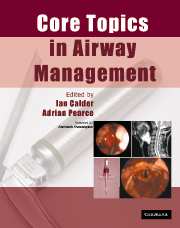Book contents
- Frontmatter
- Contents
- List of contributors
- Preface
- Acknowledgements
- List of abbreviations
- 1 Anatomy
- 2 Physiology of apnoea and hypoxia
- 3 Physics and physiology
- 4 Cleaning and disinfection of airway equipment
- 5 General principles
- 6 Maintenance of the airway during anaesthesia: supra-glottic devices
- 7 Tracheal tubes
- 8 Tracheal intubation of the adult patient
- 9 Confirmation of tracheal intubation
- 10 Extubation
- 11 Light-guided intubation: the trachlight
- 12 Fibreoptic intubation
- 13 Retrograde intubation
- 14 Endobronchial and double-lumen tubes, bronchial blockers
- 15 ‘Difficult airways’: causation and prediction
- 16 The paediatric airway
- 17 Obstructive sleep apnoea and anaesthesia
- 18 The airway in cervical trauma
- 19 The airway in cervical spine disease and surgery
- 20 The aspiration problem
- 21 The lost airway
- 22 Trauma to the airway
- 23 Airway mortality associated with anaesthesia and medico-legal aspects
- 24 ENT and maxillofacial surgery
- 25 Airway management in the ICU
- 26 The airway in obstetrics
- Index
26 - The airway in obstetrics
Published online by Cambridge University Press: 15 December 2009
- Frontmatter
- Contents
- List of contributors
- Preface
- Acknowledgements
- List of abbreviations
- 1 Anatomy
- 2 Physiology of apnoea and hypoxia
- 3 Physics and physiology
- 4 Cleaning and disinfection of airway equipment
- 5 General principles
- 6 Maintenance of the airway during anaesthesia: supra-glottic devices
- 7 Tracheal tubes
- 8 Tracheal intubation of the adult patient
- 9 Confirmation of tracheal intubation
- 10 Extubation
- 11 Light-guided intubation: the trachlight
- 12 Fibreoptic intubation
- 13 Retrograde intubation
- 14 Endobronchial and double-lumen tubes, bronchial blockers
- 15 ‘Difficult airways’: causation and prediction
- 16 The paediatric airway
- 17 Obstructive sleep apnoea and anaesthesia
- 18 The airway in cervical trauma
- 19 The airway in cervical spine disease and surgery
- 20 The aspiration problem
- 21 The lost airway
- 22 Trauma to the airway
- 23 Airway mortality associated with anaesthesia and medico-legal aspects
- 24 ENT and maxillofacial surgery
- 25 Airway management in the ICU
- 26 The airway in obstetrics
- Index
Summary
Introduction
Most anaesthetists are worried about the airway in obstetrics. This worry goes back over many years to the high incidence of difficult and failed intubation/ventilation that regularly used to feature in the Reports on Confidential Enquiries into Maternal Deaths until 15–20 years ago. Partly through better training/facilities and partly through greater use of regional anaesthesia in obstetrics, the incidence of such problems in recent reports is low. However, the possibility of unexpected difficulty remains (see below) and there is concern that recent changes in anaesthetic training in the UK have led to more limited exposure of trainees to clinical anaesthesia in general, and to general anaesthesia for Caesarean section in particular, resulting in an increase in airway problems.
The airway and pregnancy
There are several reasons why problems with the airway may be more common and serious in pregnant women than in other patients. First, technical aspects of airway management are more difficult; second, management is often particularly stressful because of the urgency of the case, increasing the importance of human factors and third, the consequences of difficulty are more serious (Table 26.1).
Prediction of difficulty with the airway is notoriously inaccurate and is covered in detail in Chapter 15. Although there are many studies of prediction of difficulty, most have excluded pregnant women. The factors that might assist prediction of difficulty are thought, in general, to be the same as for non-pregnant patients.
Non-anaesthetic airway problems
Airway problems may occur as a result of pregnancy and labour alone, albeit rarely. Pre-eclampsia is common and results in oedema which may be marked, although airway obstruction in the absence of instrumentation would be rare.
- Type
- Chapter
- Information
- Core Topics in Airway Management , pp. 197 - 200Publisher: Cambridge University PressPrint publication year: 2005

